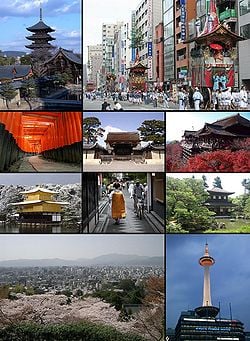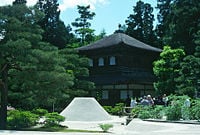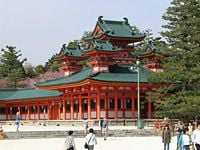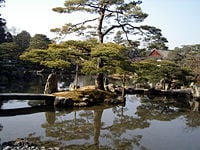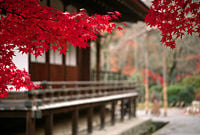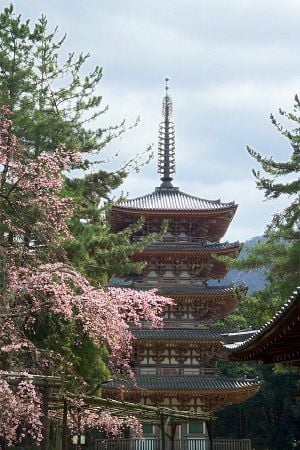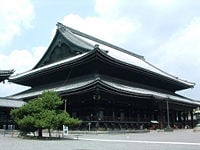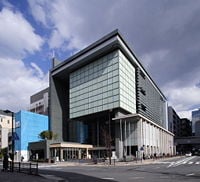Kyoto
| Kyoto 京都 Meaco (historic) |
|||
| — Designated city — | |||
| 京都市 · Kyoto City | |||
| From top left: Tō-ji, Gion Matsuri in modern Kyoto, Fushimi Inari-taisha, Kyoto Imperial Palace, Kiyomizu-dera, Kinkaku-ji, Pontochō and Maiko, Ginkaku-ji, Cityscape from Higashiyama and Kyoto Tower | |||
|
|||
| Coordinates: {{#invoke:Coordinates|coord}}{{#coordinates:35|0|42|N|135|46|6|E|type:city | |||
|---|---|---|---|
| name= }} | |||
| Country | Japan | ||
| Region | Kansai | ||
| Prefecture | Kyoto Prefecture | ||
| Government | |||
| - Mayor | Daisaku Kadokawa (門川大作) | ||
| Area | |||
| - Total | 827.90 km² (319.7 sq mi) | ||
| Population (August 1, 2011) | |||
| - Total | 1,473,746 | ||
| - Density | 1,780.1/km² (4,610.4/sq mi) | ||
| Website: City of Kyoto | |||
Kyōto (京都市, Kyōto-shi, lit. “capital capital,” or “capital of capitals") was the Imperial capital of Japan from 794 until the Meiji Restoration in 1868. It is considered the cultural center of Japan with 1,600 Buddhist temples, four hundred Shinto shrines, palaces, gardens and architectural treasures. Kyoto was spared during the fire bombing of World War II, making it the only large Japanese city that still has an abundance of pre-war buildings and a popular destination for tourists. The city has many small factories run by artisans who produce traditional Japanese crafts. Kyoto's kimono weavers are particularly renowned, and the city remains the premier center for kimono manufacturing.
Kyoto is known as one of the academic centers of Japan, and is home to 37 institutions of higher education, including Kyoto University. Today the city has a population of close to 1.5 million and is the capital of Kyoto Prefecture, as well as a major part of the Osaka-Kobe-Kyoto metropolitan area.
History
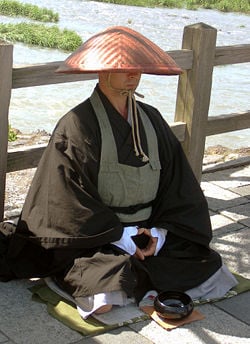
Though archaeological evidence places the first human settlement on the islands of Japan to approximately 10,000 B.C.E., relatively little is known about human activity in the area before the sixth century C.E. During the eighth century, the powerful Buddhist clergy began to interfere in the affairs of the Imperial government, and the emperor chose to relocate the capital to a region far from the Buddhist influence.
The new city, Heiankyō (平安京 , "Heian capital") became the seat of Japan's imperial court in 794. Later, the city was renamed Kyoto ("capital city"). Kyoto remained Japan's capital until the transfer of the government to Edo (now Tokyo) in 1868 at the time of the Imperial Restoration (some Japanese still consider it to be the legal capital). After Edo was renamed Tokyo, (meaning "Eastern Capital"), Kyoto was known for a short time as Saikyo (西京, Saikyō, "Western Capital").
In 1945, at the end of World War II, the Target Committee of the United States Manhattan Project placed Kyoto at the top of the list of targets for the dropping of the atomic bomb. U.S. Secretary of State Henry Stimson adamantly refused to bomb Kyoto because it "was the ancient capital of Japan, a historical city, and one that was of great religious significance to the Japanese." He had visited the city several times and was "very much impressed by its ancient culture." Kyoto was removed from the list and its architectural treasures were preserved.
Kyoto is the only large Japanese city that still has an abundance of prewar buildings, such as machiya (traditional townhouses). However, modernization is continually breaking down the traditional Kyoto in favor of newer architecture, such as the controversial Kyoto Station complex.
Kyoto became a city designated by government ordinance on September 1, 1956. In 1997, Kyoto hosted the conference that resulted in the Kyoto Protocol on greenhouse gas emissions.
An obsolete spelling for the city's name is Kiouto; it was formerly known to the West as Meaco or Miako (Japanese: 都; miyako, "capital"). Early seventeenth-century Portuguese called it Miyaco or Miaco.[1] A common English pronunciation of Kyoto has three sounds as key-oh-toe; however, the Japanese pronunciation is kyoh and to.
Geography
Kyoto is located on the middle-western portion of the island of Honshū. Surrounded on three sides by mountains known as Higashiyama, Kitayama and Nishiyama, Kyoto is famous for its stifling summer nights with no breezes. Kyoto sits above a large natural water table that provides the city with ample freshwater wells. Large scale urbanization has reduced the amount of rain draining into the table and wells across the area are drying up at an increasing rate. As of 2005, the city had an estimated population of 1,474,764 and a population density of 1,775 persons per square kilometer. The total area is 827.9 square kilometers.
The original city (the modern-day wards of Nakagyō, Shimogyō-ku and Kamigyō) was laid out in a grid pattern, modeled after the ancient Chinese capital during the Tang Dynasty, Changan, (present-day Xi'an), in accordance with traditional Chinese geomancy, with the Imperial Palace facing south. The Imperial Palace's southward orientation is also the reason why Sakyō-ku (the "Left Capital") is in the east, Ukyō-ku (the "Right Capital") is in the west. Today, the main business district is located in the south and center of town, with the less populated northern area retaining more vegetation. Surrounding areas do not follow the same grid pattern as the center of the city, though streets throughout Kyoto share the distinction of having names (Japanese streets typically are not named). Kyoto has eleven wards (ku).
Culture
Kyoto is considered the cultural center of Japan. During World War II when firebombing was conducted throughout the country, Kyoto and its ancient buildings were spared, leaving it one of the best-preserved cities in Japan. The Kyoto area has some of the most famous temples, shrines, palaces and gardens in Japan. Kiyomizu-dera (or Kiyomizudera; Japanese: 清水寺) refers to several Buddhist temples but especially to one of the best known sights of the city, Otowa-san Kiyomizu-dera (音羽山清水寺) in Eastern Kyoto. The temple was founded in 798, but the present buildings were constructed in 1633. It takes its name from the waterfall within the complex, which runs off the nearby hills—kiyoi mizu (清い水, literally “pure water”).
The main hall of Kiyomizu-dera is notable for its vast veranda, supported by hundreds of pillars, which juts out over the hillside and offers impressive views of the city. The expression "to jump off the stage at Kiyomizu" (「清水の舞台から飛び降りる」) refers to an Edo period tradition that held that, if one were to survive jumping from the stage, one's wish would be granted.
Beneath the main hall is the waterfall Otowa-no-taki, where three channels of water, which is believed to have therapeutic properties and confer health, longevity, and success in studies on anyone who imbibes them, drop into a pond. The temple complex contains several other shrines, notably Jishu-jinja, including Okuninushino-Mikoto, a god of love and "good matches." Jishu-jinja possesses a pair of "love stones" placed 18 meters apart, which lonely visitors attempt to walk between with their eyes closed. Success in reaching the other stone, eyes closed, is taken as a presage that the pilgrim will find love.
Kinkaku-ji (金閣寺, Golden Pavilion Temple), the informal name of Rokuon-ji (鹿苑寺, “Deer Garden Temple”), was originally built in 1397 as a retirement villa for Shogun Ashikaga Yoshimitsu. His son converted the building into a Zen temple of the Rinzai school. The temple was burned down several times during the Ōnin War. The entire pavilion except the basement floor is covered with pure gold leaf. The pavilion functions as a shariden, housing relics of the Buddha. On the roof of the pavilion is a golden fenghuang or "Chinese phoenix." The temple was burned down in 1950 by a mentally disturbed monk; the present structure dates from 1955, and restoration of the gold leaf and lacquer coatings was completed in 1987.
Ginkaku-ji ( 銀閣寺), the "Temple of the Silver Pavilion," is a Buddhist temple in the Higashiyama District of Kyoto. The temple's official name is Jishō-ji (慈照寺). It was built in 1474 by the shogun Ashikaga Yoshimasa, who sought to emulate the golden Kinkaku-ji commissioned by his grandfather Ashikaga Yoshimitsu. The Kannon hall, known as Ginkaku, the Silver Pavilion, was originally to be covered in silver, but construction was halted due to the increasing severity of the Ōnin War, which broke out in 1467, and the silver covering never placed on the pavilion. The building, originally intended to be a monument to ostentation, is now taken as an example of Japanese refinement and restraint.
Like Kinkaku-ji, Ginkaku-ji was originally built to serve as a place of rest and solitude for the Shogun. It is said Ashikaga Yoshimasa sat in the pavilion, contemplating the calm and beauty of the gardens as the Ōnin War worsened and Kyoto was burned to the ground. In 1485, Yoshimasa became a Zen Buddhist monk, and after his death the villa became a Buddhist temple, renamed Jishō-ji.
In addition to that building, the temple features wooded grounds covered with a variety of mosses, and a Japanese garden, supposedly designed by the great landscape artist Soami. The rock and sand garden of Ginkaku-ji is particularly famous, and a pile of sand said to symbolize Mount Fuji has now come to be a part of the garden.
The Heian Jingū (平安神宮) is a Shinto shrine. The torii before the main gate is one of the largest in Japan, and the main building, or shaden (社殿), is designed to imitate the Kyoto Imperial Palace. It was built in 1895 for the 1,100th anniversary of the establishment of Heiankyō (the old name of Kyoto). The shrine is dedicated to Emperor Kammu, who moved the capital to Heian and Emperor Kōmei, the last before Emperor Meiji moved the capital to Tokyo.
Ryōan-ji (Shinjitai, 竜安寺; Kyūjitai, 龍安寺, The Temple of the Peaceful Dragon) is a Zen temple located in northwest Kyoto. Belonging to the Myōshinji school of the Rinzai branch of Zen Buddhism, the temple is famous for its karesansui (dry landscape) rock garden, thought to have been built in the late 1400s. The garden consists of raked gravel and fifteen moss-covered boulders, which are placed so that, when looking at the garden from any angle (other than from above) only fourteen of the boulders are visible at one time. It is traditionally said that only through attaining enlightenment would one be able to view the fifteenth boulder.
Kyoto Imperial Palace (Kyōto Gosho, 京都御所) was the Imperial Palace of Japan for much of its history, from the Heian Period, when the Imperial capital was moved from Nara to Heian-kyo (平安京), (Kyoto), until the Meiji Restoration, when the capital was moved to Tokyo. The Taisho and Showa Emperors had their coronation ceremonies at Kyōto Gosho. Since it was first built in 794, the palace has been destroyed and rebuilt eight times, six of them during the 250-year-long peace of the Edo period. The version currently standing was completed in 1855, the Heian period architecture and style reproduced perfectly.
The main gate on the front, south, side of the palace has a cypress-wood roof, and is supported by four pillars. On either side of it trees were planted, which would become very famous and sacred, a cherry (sakura) on the left, and a tachibana tree on the right. This gate was used on the rare occasions by the emperor to welcome a foreign diplomat or dignitary, as well as for many other important ceremonies of the state.
The Katsura Imperial Villa (桂離宮, Katsura Rikyū), or Katsura Detached Palace, one of Japan's most important large-scale cultural treasures, is a villa with associated gardens and outbuildings in the western suburbs of Kyoto. Its gardens are masterpieces of Japanese gardening, and the buildings are one of the greatest achievements of Japanese architecture.
Prince Toshihito (智仁; 1579 -1629), the first of the Hachijo-no-miya line, established the villa at Katsura. The shoin of Katsura Imperial Villa is divided into three parts: the Old Shoin (built in around 1615 C.E.), the Middle Shoin, and the New Palace, each in the shoin style, with irimoya kokerabuki (柿葺) roofs. The Old Shoin shows elements of the sukiya style; a platform for viewing the moon protrudes from the veranda. The walls of the Middle Shoin and New Palace have ink-paintings by the school of Kanō Tan'yū (狩野 探幽). The strolling garden takes water from the Katsura River for the central pond, around which are the Shōkintei (松琴亭), Shōkatei (賞花亭), Shōiken (笑意軒), a Buddhist hall, Onrindō (園林堂), and Gepparō (月波楼); tea houses, hill, sand, bridge, and lanterns.
The Shūgaku-in Imperial Villa (修学院離宮, Shūgaku-in Rikyū) or Shūgaku-in Detached Palace, a set of gardens and outbuildings (mostly tea-houses) in the hills of the eastern suburbs of Kyoto, is a cultural treasure famous for its Japanese gardens. There are no large scale buildings, and the grounds include three separate gardens, the Lower Garden, Middle Garden (a later addition), and Upper Garden, of which the latter is the most important.
The Shūgaku-in was originally constructed 1655 – 1659 by the retired Emperor Go-Mizunoo. The Upper Garden features a large artificial pond, created by building an earthen dam across a ravine; the pond contains a number of small islands. Unlike the typical Japanese garden, it is a very large stroll garden, making extensive use of the technique of "borrowed scenery." After Go-Mizunoo's death, his daughter Princess Mitsuko became a nun, and established another temple there, the Ryinku-ji, in what later became the Middle Garden.
Tenryū-ji (天龍寺), more formally known as Tenryū Shiseizen-ji (天龍資聖禅寺), located in Susukinobaba-chō, Ukyō Ward, is the head temple of the Tenryū sect of Rinzai Zen Buddhism. The temple was founded by Ashikaga Takauji, primarily to venerate Gautama Buddha, and its first chief priest was Musō Soseki. The temple is ranked as the most important (Rinzai) Zen temple in Kyoto.
In the early Heian period, Empress Tachibana no Kachiko, wife of Emperor Saga, founded a temple called Danrin-ji (檀林寺) on the site of present-day Tenryū-ji. The temple fell into disrepair over the next four hundred years, before, in the mid-thirteenth century, Emperor Gosaga and his son Emperor Kameyama turned the area into an imperial villa they christened "Kameyama Detatched Palace" (亀山殿, kameyamadono). The name "Kameyama," which literally means "turtle mountain," was selected due to the shape of Mount Ogura, which lies to the west of Tenryū-ji—it is said to be similar to the shape of a turtle's shell. The palace was converted into a temple at the behest of Ashikaga Takauji, who became shogun in 1338. Ashikaga had opposed the failed Kemmu Restoration initiated by Emperor Go-daigo, who then decreed that Ashikaga should be hunted down and executed. When Emperor Go-daigo passed away, Ashikaga recommended that Zen monk Musō Soseki construct a temple for his memorial service. At one time, the massive grounds (roughly 330,000 square meters) were said to contain some 150 sub-temples, however, the temple was plagued with numerous fires, and all of the original buildings have been destroyed. Most of the buildings seen today are reconstructions from the latter half of the Meiji period.
The Kamo Shrines, Kamigamo Jinja (上鴨神社), and Shimogamo Jinja (下鴨神社) are a pair of Shinto shrines, dedicated to Kamo Wake-ikazuchi, the kami of thunder, and feature prominently in the Aoi Festival, which occurs in May and involves a procession between the two shrines, horse races, and archery.
Kamigamo Shrine, the “higher” or “upper” Kamo Shrine, dating most likely to the seventh century, is famous for its Haiden hall, rebuilt in 1628. A number of priests' residences are situated on its grounds. Its two large conical sand mounds memorialize the holy trees that once served to welcome spirits.
The Shimogamo Shrine, the “lower” Kamo Shrine, believed to be a century older, was originally built to protect the then-new capital city of Heian-kyo (Kyoto). It has since become one of the key shrines in the area entrusted with ensuring the success of the annual rice harvest. The Shimogamo Shrine is located within Tadasu no Mori (糺すの森), “the forest of truth,” a primeval forest which is supposed to have never been burnt or chopped down. The forest suffered some damage over the ages, as Kyoto was burned during successive revolts and wars, but has rebounded and is considered to be natural, not pruned or planted by man. Shimogamo Shrine is also known as "Kamomioya Shrine" (賀茂御祖神社, kamomioya jinja).
"Tō-ji" (東寺) is a Buddhist temple of the Shingon sect. Its name means East Temple, and it once had a partner, Saiji (West Temple). They stood alongside the Rashomon Gate, the gate to the Heian capital. It is also known as "Kyō-ō-gokoku-ji" (教王護国寺) which indicates that it previously functioned as a temple providing protection for the nation. Although often associated with the famous priest Kōbō Daishi (Kūkai), Tō-ji was established in 796 C.E., two years after the capital moved to Heian-kyō. Kūkai was put in charge of Tō-ji in 823 C.E. by order of Emperor Saga. Its principal image is of Yakushi Nyorai, the healing Buddha.
The pagoda of Tō-ji stands 57 meters high, and is the tallest wooden tower in Japan. It dates from the Edo period, when it was rebuilt by order of the third Tokugawa Shogun, Iemitsu. The pagoda has been, and continues to be, a symbol of Kyoto. On the 21st of each month, a famous flea market is held on the Tō-ji temple grounds. This market is popularly called Kōbō-san, in honor of Kōbō Daishi, who died on March 21.
Daigo-ji (醍醐寺) is a Shingon Buddhist temple in Fushimi-ku. The main image (honzon) is Yakushi. Rigen-daishi (Shōbō) founded the temple in 874. More than seven centuries later, Toyotomi Hideyoshi held a famous cherry-blossom viewing party there.
- Ninna-ji (仁和寺) is a large Omura-ha Shingon Buddhist temple complex in eastern Kyoto, founded in 888 by the retired Emperor Uda. From 888 until 1869, it was traditional for reigning emperors to send a son to the temple to take over as head priest when a vacancy arose.
Saihō-ji (西芳寺), a Rinzai Zen Buddhist temple famed for its moss garden, is commonly referred to as "Koke-dera" (苔寺) meaning "moss temple," and is also known as "Kōinzan Saihō-ji" (洪隠山西芳寺). According to temple legend, Saihō-ji was constructed during the Nara period by Gyōki, on the location of one of Prince Shōtoku's former retreats. The temple first operated as a Hossō temple dedicated to Amitabha, and was known as "Saihō-ji" (西方寺) a homophone of the current name. The name was selected because Amitabha is the primary buddha of Pure Land Buddhism, known in Japanese as "Saihō Gokuraku Jōdo" (西方 極楽浄土). Legend states that such famous Japanese monks as Kūkai and Hōnen later served as the chief priests of the temple. Although the veracity of these legends is questionable, it is believed that such a predecessor to the current temple did, in fact, exist.
Over time, the temple fell into disrepair, and in 1339, the chief priest of the nearby Matsunoo Shrine, Fujiwara Chikahide, summoned the famous Japanese gardener Musō Soseki to help him revive Saihō-ji as a Zen temple. Saihō-ji was destroyed by fire during the Ōnin War, and twice ravaged by floods during the Edo period, but has since been rebuilt.
Ironically, the moss for which the temple is known was not part of Musō's original design. According to French historian François Berthier, the garden's "islands" were "carpeted with white sand" in the fourteenth century. The moss came much later, of its own accord during the Meiji era (1860-1912), when the monastery lacked sufficient funds for upkeep.[2]
Hongan-ji (本願寺, temple of the original vow) is the name of a number of Buddhist temples through Japan's history. However, it refers primarily to a pair of temples, which were once one, in Kyoto. The Hongan-ji was established as a temple in 1321, on the site of the Otani Mausoleum, where Shinran, the founder of the Jodo Shinshu (True Pure Land) sect was buried. Kakunyo became the first chief priest of the Hongan-ji, and dedicated it to the worship of Amida Buddha. The Hongan-ji first gained power and importance in the fifteenth century, when Rennyo became its eighth chief priest. However, the Tendai sect, based on Mount Hiei, saw this expansion as a threat and attacked the Hongan-ji three times with their army of sohei (warrior monks). Rennyo fled to Yoshizaki, Fukui where he founded the Ikko sect. During the Sengoku period, fearing the power of the monks of the Hongan-ji, Oda Nobunaga tried to destroy it. For ten years, he laid siege to the Ishiyama Hongan-ji in Osaka, one of the two primary temple fortresses of the Ikko sect.[3]
In 1602, just after Tokugawa Ieyasu became shogun, he decreed that the Hongan-ji be split in two. Kyonyo, the twelfth chief priest of Hongan-ji became the first of the Higashi Honganji (or, “The Eastern Temple of the Original Vow”), while Junyo became chief priest of the Nishi Honganji (or, “The Western Temple of the Original Vow”).[3]
During the Meiji Restoration in the 1860s, the government set down new guidelines for the management of religious organizations and an organization called Shinshu Otani was put in control of the Higashi Hongan-ji. In 1987, the temple was renamed "Shinshu Honbyo," or New Buddhist Mausoleum, and its purpose reverted to that of a mausoleum.
The Nishi Hongan-ji (西本願寺), like the Higashi Hongan-ji, features a huge Goei-do (御影堂), founder's hall and a smaller Amida-do (阿弥陀堂), or Buddha hall, housing an image of the Amida Buddha. It also contains two Noh stages, one of which claims to be the oldest in existence, and the Kokei no Niwa (虎渓の庭) gardens.
The Goei-do at Higashi Hongan-ji dates from 1895 and vies with a number of other structures for the claim of largest wooden building in the world.
Other notable sites in and around Kyoto include Kōzan-ji, the Nijo Castle, Arashiyama and its picturesque lake, the Gion and Pontochō geisha quarters, the Philosopher's Walk (a favorite path of philosopher Kitaro Nishida), and the canals which line some of the older streets. The "Historic Monuments of Ancient Kyoto" are listed by UNESCO as a World Heritage Site.
Economy
Tourism forms the base of Kyoto's economy. The city's cultural sites are constantly visited by school groups from across Japan, and many foreign tourists also stop in Kyoto. Kyoto is renowned for its abundance of delicious ethnic foods and cuisine.
The city's industry is mainly comprised of small factories, most of which are run by artisans who produce traditional Japanese crafts. Kyoto's kimono weavers are particularly renowned, and the city remains the premier center for kimono manufacturing. These businesses, vibrant in past centuries, have declined in recent years as traditional goods are in less demand.
Kyoto's only sizable heavy industry is electronics: the city is home to the headquarters of Nintendo, as well as the headquarters of OMRON, Kyocera (Kyoto Ceramic) and Murata Machinery. The apparel giant Wacoal also operates in Kyoto. However, the growth of high-tech industry has not compensated for the decline in traditional industry, and as a result, Kyoto's total manufacturing output has declined relative to other cities in Japan.
The Toei Uzumasa Eigamura (also known as Kyoto Studio Park and Toei Movie Land) is called the "Hollywood of Japan."[4] Like Universal Studios, Eigamura is a film set and theme park in one, and many Japanese period movies were shot here. It features replicas of traditional Japanese buildings including the old Nihonbashi Bridge, a traditional court house, a Meiji period police box and part of the former Yoshiwara red light district, which are used as settings for period movies and television dramas. Occasionally an actual film shooting takes place, and park visitors are welcome to observe the action.
Colleges and Universities
Kyoto is known as one of the academic centers of Japan, and is home to 37 institutions of higher education. The three largest and best-known local universities are Doshisha University, Kyoto University, and Ritsumeikan University. Kyoto University is considered to be one of the top universities in Japan, boasting several Nobel laureates such as Yukawa Hideki.
Kyoto also has a unique higher education network called the Consortium of Universities in Kyoto, which consists of three national, five public (prefectural and municipal), and 41 private universities, as well as the city and four other organizations. The consortium does not offer a degree; hence is not a federal body like University of London, but offers the courses as part of a degree at participating universities.
Transportation
The city transportation is centered around Kyoto Station (京都駅, Kyoto-eki). The station is the second largest in Japan and holds a shopping mall, hotel, movie theater, Isetan department store, and several local government facilities under one fifteen-story roof. The Tokaido Shinkansen Line (see below) as well as all local rail lines connect here. For many travelers it is a hub of travel and a good place to catch all the buses the city has to offer.
Kyoto's municipal bus network and subway system are extensive. Private carriers also operate within the city. Many tourists join commuters on the public buses, or take taxis or tour buses.
Bicycles are an important form of personal transportation in the city, and are considered a part of Kyoto's urban identity. The geography and scale of the city are such that the city may be easily navigated on a bicycle.
Sports
In soccer, Kyoto is represented by Kyoto Purple Sanga who rose to J. League's Division 1 in 2005. Because of the popularity of the nearby Hanshin Tigers, Kyoto has never had a team in Japanese professional baseball, though the Tigers play several neutral-site games at Kyoto's Nishi Kyogoku stadium every year, but Kyoto's high school baseball teams are strong.
Sister cities
- Boston, Massachusetts, United States
- Paris, France
- Cologne, Germany
- Prague, Czech Republic
- Florence, Italy
- Kiev, Ukraine
- Xi'an, People's Republic of China
- Guadalajara, Mexico
- Jinju, Republic of Korea
- Zagreb, Croatia[5]
Notes
- ↑ João Rodriguez, Arte da Lingoa de Iapam (1604).
- ↑ François Berthier, 2000, Reading Zen in the Rocks (Chicago, IL: The University of Chicago Press, 2005, ISBN 0226044122), 25.
- ↑ 3.0 3.1 Esben Andreasen, Popular Buddhism In Japan: Shin Buddhist Religion & Culture (University of Hawaii Press, 1998, ISBN 0824820282), 11.
- ↑ Toei Uzumasa Eigamura Movie Museum, Welcome to Kyoto: English Sightseeing Website. Retrieved August 17, 2007.
- ↑ Sister and Other Associated Cities, Kyoto City Web. Retrieved August 17, 2007.
ReferencesISBN links support NWE through referral fees
- Cary, O. Mr. Stimson's 'Pet City'-the Sparing of Kyoto, 1945: Atomic Bomb Targeting Myths and Realities. Kyoto: Amherst House, Doshisha University, 1987.
- Clancy, J. Exploring Kyoto: On Foot in the Ancient Capital, 1st ed. Weatherhill, 1997. ISBN 0834803836
- Ono, M. and K. Mizuno. The Hidden Gardens of Kyoto. Kodansha International, 2004. ISBN 4770029373
- Rowthorn, C. Lonely Planet Kyoto: City Guide, 3rd ed. Lonely Planet Publications, 2005. ISBN 174104085X
- Treib, M. and R. Herman. A Guide to the Gardens of Kyoto. New York: Oxford University Press, 2003. ISBN 4770029535
External links
All links retrieved October 5, 2022.
Credits
New World Encyclopedia writers and editors rewrote and completed the Wikipedia article in accordance with New World Encyclopedia standards. This article abides by terms of the Creative Commons CC-by-sa 3.0 License (CC-by-sa), which may be used and disseminated with proper attribution. Credit is due under the terms of this license that can reference both the New World Encyclopedia contributors and the selfless volunteer contributors of the Wikimedia Foundation. To cite this article click here for a list of acceptable citing formats.The history of earlier contributions by wikipedians is accessible to researchers here:
- Tenryū-ji history
- Kamo_Shrine history
- Tō-ji history
- Daigo-ji history
- Ninna-ji history
- Saihō-ji history
- Hongan-ji history
- Kyoto history
- Kiyomizu-dera history
- Kinkaku-ji history
- Heian_Jingū history
- Ginkaku-ji history
- Ryōan-ji history
- Kyoto_Gosho history
- Katsura_Imperial_Villa history
- Shugaku-in_Imperial_Villa history
The history of this article since it was imported to New World Encyclopedia:
Note: Some restrictions may apply to use of individual images which are separately licensed.
